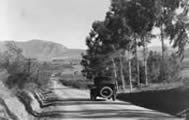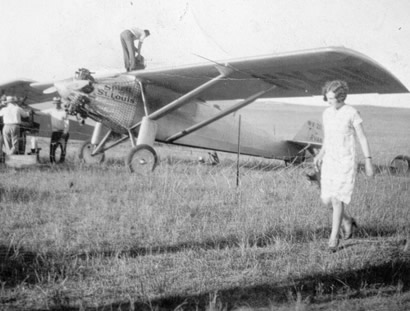Photo: Charles Lindbergh's
Spirit of St. Louis
By Vic Head
Written 1998
Twelve boys, all six or seven years of age were called out of our cottage at the Lomaland School to see the “Shannon Door” in the sky over Point Loma. It looked about three times as long as a watermelon. When our caretaker lady said there were about forty people on it, we could only suppose they must be elves or gnomes, perhaps as tall as string beans. This was in 1924 or perhaps early 1925. Later I learned that it was the U. S. Navy Dirigible ZR-1, called the Shenandoah, almost 700 feet long, which broke up in a storm over Ohio in May of 1925, when one-third of those on board lost their lives. Strange how falsely small can seem large objects in the sky, but then consider the full moon, 2000 miles across, which some say looks the size of a dinner plate and others put at the size of a dime.
There were biplanes flying over Point Loma in those days and we were plagued by the same illusion—perhaps a foot and half wingspread, a little larger than the toy airplanes some of the boys had. That they were really large enough to carry people seemed fantastic until we watched a few years later as one of them came down out of the sky on a grassy field and came to a stop right in front of us. There were perhaps, a dozen biplanes wing tip to wing tip there on the grass, a place called Lindbergh Field. Then we heard the story of Charles A. Lindbergh and his Spirit of St. Louis, a monoplane in which he had recently been the first to fly solo nonstop from New York to Paris.
Oh, how I longed to fly!
For a few months the four of us and our mother lived in La Mesa, east of San Diego, where most of the schoolboys had tiny gliders made of three pieces of balsa, with perhaps 8-inch wingspread. Some were simply launched from the hand, and some with a rubber band. What thrilling graceful paths they took when a thumbtack was placed by trial and error in the nose, a high loop-the-loop, a long glide skimming a couple of inches above the adobe school yard only to climb a foot or more.
They cost a quarter a piece. My mother didn’t have a quarter to spare. I simply had to have one. Awake at 6 a.m., I stole a quarter from my sister Sylvia’s purse and hiked up the spiral road to the top of Mount Nebo. Back in time for breakfast. “Mother, look what I found on the road.” Sylvia, “There’s a quarter missing from my purse.” The yardstick made only gentle love pats on my calves, but the tears streaming down Mother’s face brought extreme remorse, and it was years before I owned such a simple little toy. My Grandmother Borden in far away New Hampshire heard the story and sent me an airplane for Christmas, a cast-iron toy with four-inch wingspread and quarter-inch turnable wheels. I suppose a three-year-old might have had fun pushing it around on the floor and screaming “brr-rr-rr”—Grandmothers mean well.
The year 1929 saw big changes in our lives, as we moved east to New Hampshire, where the school kids named me “Applesauce California,” soon reduced to simply, “Hey, Sauce!” There was real snow under foot and a beautiful hill for sliding in pasture land behind the one-room schoolhouse. The kids would build a jump, pour water on it and let it freeze overnight. Once in a while Carl let me ride on my knees, as he lay prone on his sled. “Almost like flying,” I said of the jump. “You bet, Sauce,” said Clifford, “and sometimes we do. We fasten thin boards from orange crates onto our sleds and then when we go over a jump like this, we can glide a hundred feet or so down into the valley.”
Gullible Sauce believed.
Oh, how I wanted to fly!
At home there was a rock retaining wall about two feet high between the upper level lawn and the lower level of Mother’s petunia bed where the hawk moths used to hover at dusk like hummingbirds. Boy, could they fly! I found some old plaster laths and some hay caps in the barn, and made a sort of wing. I could stand in the middle with it projecting a couple of feet to either side, and I would run and jump off the retaining wall and imagine I was airborne for three or four feet farther than I could have jumped without it. But I always fell to my knees when I landed and my left knee still has the swollen bump.
Oh, how I wanted to fly!
In 1929 or 1930, Popular Mechanics Magazine published a science fiction story called “Haunted Airways.” I don’t remember the sinister plot, but I do remember the ridiculous description of airplanes made of metal! And airplanes with 100-foot wingspread! To say nothing of airplanes that could fly at 1,000 miles an hour. But then came another issue in the thirties that told how to build a biplane glider fashioned after one that the Wright Brothers had built at Kitty Hawk and flown from Kill Devil Hill, a sand dune on the Outer Banks off North Carolina. This was in advance of their motorized flight, first in human history. That was in 1903, fourteen years before I was born. There were some differences. The Wright Brothers’ glider had wings that could be warped by forces properly applied by arms and legs to give some steering capability, while the Popular Mechanics version with two 20-foot by 4-foot wings, was rigidized with piano wire and controlled by shifting your weight. There was a rigid tail for stability. Knot-free spruce 20-feet long and planed to ¾” x 1 ½” was the most expensive component, and many a quart of blueberries picked and peddled door-to-door paid for the four spars, uprights, and tail structure. Plaster laths from the barn, each ripped in two lengthwise and planed, provided eighty pieces to give camber, and each wing was covered with the cheapest muslin I could buy at nine cents a yard. Blueberry season was gone when I discovered I needed another $2.00 worth of piano wire, so back to weeding neighbors’ gardens at 10 cents an hour, and another eight-mile round trip hike to Concord. Years later Mother told me her heart was in her mouth the whole summer, but she never showed it.
The Dimond Hill Dairy Farm was just down the road. There was a stone wall parallel to the brow of the hill and down from the top, and I placed a plank from the uphill side to the top of the wall. I could run with the two arm supports under my arms until airborne, but much to my disgust, the rigid tail structure fell from the plank to the ground just below the stone wall. I didn’t know that my weight, being too far back, put me in what aerodynamics people would have called a “stall,” but after many days I came to realize that there would be no flight if I didn’t pull my weight forward. Came the last day of summer vacation before I would have to take the train back to school. One last try. Weight properly forward, and I was really flying, but the tip of the right wing touched the ground before my feet did. I hadn’t thought of wing-tip skids. WOP! The tail was straight up, the front of both upper and lower wings on the ground after spinning a quarter circle, and I was flat on my belly with my wind knocked out and gasping for air for a few seconds, but no harm done. In retrospect I know I could have killed myself if it hadn’t happened just the way it did, for at the bottom of Dimond Hill was another stone wall and a dense woods and, kid-like, I’d given no thought to how to stop. Anyway, I had been airborne by my own glider for sixty or eighty feet, which was more than that prankster Clifford was ever likely to be. In passing, I should add that the cheap unpainted muslin let so much air ooze through it that it never would have supported a grown man.
Very recently a documentary on the life of the famed World War I “ace” Jimmy Doolittle appeared on TV. He was also a general in the Army Air Corps in World War II before this corps became a third branch of our armed services in 1947. What delight to learn that, between wars, he had seen the same issue of Popular Mechanics in the early thirties and built a glider to the same design. He tried to fly it off a small cliff but lost altitude before the tail was off the top of the cliff. He was unhurt, but his glider was shattered.
A couple years later in the mid-thirties, a buddy and I camped in Franconia Notch, NH, under the famous Great Stone Face. Then, hitchhiking south, we were walking when we saw a small airplane on a lawn, with a sign: “Fly--$10.00.” We only had $5.00 between us, but the owner, farmer and part-time pilot said, “OK. Shorter ride, but we’ll do it.”
Oh, how I wanted to fly! And at last we did. I can’t remember if it was a monoplane or biplane—the former I think, with a two-seat open cockpit. Yes, it must have been a monoplane. In no time, we were off the ground and flying down the valley past a village where a church steeple was conspicuous. Then an absolutely unbelievable thing happened. The floor of the valley suddenly tilted and became a vertical wall to our right, and there was the steeple tilted horizontal and pointing straight at us, while off to the left there was no horizon. And so my buddy and I learned that when a plane banks, the sensation “down” is where one’s bottom presses against the seat, even though the force may be ninety parts centrifugal and only ten parts earth’s gravity. But the ground righted itself, the wind whistled, the grassy field was rising to meet us, and our five-minute ride was over.
A few years later, during World War II, I was instrument engineer at General Electric’s Supercharger Division in Lynn, MA. We built an altitude wind tunnel and tested the power plant of the famed B-29, one of its four engines and two of its eight superchargers, and determined the altitude ceiling—about 29,000 feet as I recall, above which operation became unstable. Then the Supercharger Division became the Aircraft Gas Turbine Division where we built and tested the first jet engine ever made in the United States—a tiny engine with only 4,000 pounds thrust, designed by a British engineer. We measured fuel consumption with gadgets called rotameters made by Fischer and Porter, and that’s how it came to be that after the war I came to work for them and live in Hatboro (Pennsylvania). But it was twenty years later before I ever rode in a jet-propelled plane. Then I flew into San Diego only to discover that that grassy spot called Lindbergh Field had grown to become San Diego’s Lindbergh International Airport.




